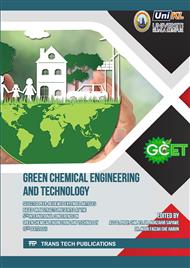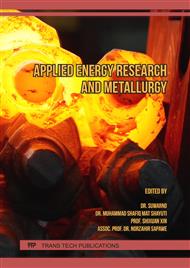[1]
L. Koehnken, M.S. Rintoul, M. Goichot, D. Tickner, A.C. Loftus & M.C. Acreman, Impacts of Riverine Sand Mining On Freshwater Ecosystems: A review of the scientific evidence and guidance for future research, River Research and Applications. (2020) 362-370.
DOI: 10.1002/rra.3586
Google Scholar
[2]
M.A. Peter, A. Muntean, S.A. Meier & M. Böhm, Competition of several carbonation reactions in concrete: a parametric study, Cement and Concrete Research. (2008) 1385-1393.
DOI: 10.1016/j.cemconres.2008.09.003
Google Scholar
[3]
J.S. Dennis & R. Pacciani, The rate and extent of uptake of CO₂ by a synthetic, CaO-containing sorbent, Chemical Engineering Science. (2009) 2147-2157.
DOI: 10.1016/j.ces.2009.01.051
Google Scholar
[4]
E. S. Rentier and L. H. Cammeraat, The environmental impacts of river sand mining,, Science of The Total Environment, 838, 155877, (2022).
DOI: 10.1016/j.scitotenv.2022.155877
Google Scholar
[5]
N. Razali, R.N.F.R. Aris, N. Razali & K.F. Pa'ee, Revalorization of aquaculture waste: the performance of calcined mussel shells as partial cement replacement, International Conference on Environmental Research and Technology (ICERT 2017). (2017) 375-381.
DOI: 10.1504/ijee.2018.097515
Google Scholar
[6]
A.C. Sankh, P.M. Biradar, S.J. Naghathan, M.B. Ishwargol, Recent trends in replacement of natural sand with different alternatives, IOSR Journal of Mechanical and Civil Engineering. (2014) 59-66.
Google Scholar
[7]
B. Prasad & K.K. Mondal heavy metals leaching in Indian fly ash. Europe PMC, (2008). 127-132.
Google Scholar
[8]
C. Heidrich, H.J. Feuerborn & A. Weir, Coal combustion product: a global perspective, World Coal Ash (WOCA) Conference. (2013).
Google Scholar
[9]
N.M. Musyoka, L.F. Petrik, O. Fatoba & E. Hums. Synthesis of zeolites from coal fly ash using mine waters, Minerals Engineering. (2013) 9-15.
DOI: 10.1016/j.mineng.2013.06.019
Google Scholar
[10]
W. Gwenzi & N. M. Mupatsi. Evaluation of heavy metal leaching from coal ash-versus conventional concrete monoliths and debris. Waste Management. (2016) 114-123.
DOI: 10.1016/j.wasman.2015.12.029
Google Scholar
[11]
M.K.P Raseela & B.M.S. George, Experimental investigation on the use of cockle shell as partial coarse aggregate replacement in concrete, International Research Journal of Advanced Engineering and Science. (2019) 504-510.
Google Scholar
[12]
U.G. Eziefula, J.C. Ezeh & B.I. Eziefula, Properties of seashell aggregate concrete: a review. Construction and Building Materials. (2018) 287–300.
DOI: 10.1016/j.conbuildmat.2018.10.096
Google Scholar
[13]
I. Brás, P.C. Silva, R.Almeida, M. E. Silva & C. Lourenço, Eco-toxicity assessment of concrete prepared with industrial wastes, Energy Procedia. 136 (2017) 115–120.
DOI: 10.1016/j.egypro.2017.10.296
Google Scholar
[14]
P. Nanthagopalan & M. Santhanam, Fresh and hardened properties of self-compacting concrete produced with manufactured sand, Cement and Concrete Composites. 33 (2011) 353-358.
DOI: 10.1016/j.cemconcomp.2010.11.005
Google Scholar
[15]
P.A. Jadhav & D.K. Kulkarni, Effect of replacement of natural sand by manufactured sand on the properties of cement mortar, International Journal of Civil And Structural Engineering. 3 (2013) 621-628.
Google Scholar
[16]
S. Evanevil & B. Vijaya, Manufactured sand, a solution and an alternative to river sand in concrete manufacturing, International Journal of Civil Engineering Research and Development (IJCERD). 3 (2013) 20-24.
Google Scholar
[17]
P. Bhavana and T. Srinivas, Manufactured sand effect on flexural behavior of geopolymer RCC structural elements, AIP Conference Proceedings 2358, 020007 (2021).
DOI: 10.1063/5.0058556
Google Scholar
[18]
I. Abdulrahman, H.I. Tijani, B.A Mohammed, H. Saidu, H. Yusuf, M.N. Jibrin, & S. Mohammed, From garbage to biomaterials: an overview on eggshell-based hydroxyapatite. Journal of Materials. (2014) 1-6.
DOI: 10.1155/2014/802467
Google Scholar
[19]
De Angelis, G., Medeghini, L., Conte, A.M., and Mignardi, S. (2017). Recycling of Eggshell Waste into Low-Cost Adsorbents for Ni Removal from Wastewater. Journal of Cleaner Production, 164: 1497-1506.
DOI: 10.1016/j.jclepro.2017.07.085
Google Scholar
[20]
Ahmed, T. A. E., Younes, M., Wu, L., & Hincke, M. T. (2021). A Survey of Recent Patents in Engineering Technology for the Screening, Separation and Processing of Eggshell. Frontiers in Bioengineering and Biotechnology, 9.
DOI: 10.3389/fbioe.2021.677559
Google Scholar
[21]
FAO (2020). Livestock Primary. FAOSTAT. Available online at: http://www.fao.org/ faostat/en/#data/QL (accessed November 5, 2020).
Google Scholar
[22]
A.L. Winton, Poultry eggs, Agrobios Publishers, Behind Nasrani Cinema, India, (2003).
Google Scholar
[23]
M. Sivakumar & N. Mahendran. Strength and permeability properties of concrete using fly ash (FA) rise husk ash (RHA) and eggshell powder (ESP), Journal of Theoretical and Applied Information Technology. 66 (2014) 489-499.
Google Scholar
[24]
M. Balaz, Eggshell membrane biomaterial as a platform for applications in materials science, Acta Biomaterialia. 10 (2014) 3827-3843.
DOI: 10.1016/j.actbio.2014.03.020
Google Scholar
[25]
S.B. Hassana & V.S. Aigbodionb, Effects of eggshell on the microstructures and properties of Al–Cu–Mg/eggshell particulate composites. Journal of King Saud University - Engineering Sciences. (2015) 49-56.
DOI: 10.1016/j.jksues.2013.03.001
Google Scholar
[26]
S.A. Raji & A. T. Samuel, Eggshell as a fine aggregate in concrete for sustainable construction. International Journal of Science & Technology. (2015) 8-13.
Google Scholar
[27]
U.N Okonkwo, I.C Odiong &, E.E. Akpabio, The effect of eggshell ash on strength properties of cement-stabilized lateritic. International Journal of Sustainable Construction Engineering & Technology. 3 (2012) 18–25.
Google Scholar
[28]
K. Wang, V. Schaefer & J. Kevern, Development of mix proportion for functional and durable pervious concrete, Materials Science. (2006) 1-12.
Google Scholar
[29]
K. Nandhini, & J. Karthikeyan, Sustainable and greener concrete production by utilizing waste eggshell powder as cementitious material – A review. Construction and Building Materials, 335, 127482 (2022).
DOI: 10.1016/j.conbuildmat.2022.127482
Google Scholar
[30]
A. A. Jhatial, W. I. Goh, S. Sohu, S. A. Mangi, & A. K. Mastoi, Preliminary Investigation of Thermal Behavior of Lightweight Foamed Concrete Incorporating Palm Oil Fuel Ash and Eggshell Powder, Periodica Polytechnica Civil Engineering. 65 (2021), 168–180.
DOI: 10.3311/ppci.16498
Google Scholar
[31]
H. Y. Tiong, S. K. Lim, Y. L. Lee, C. F. Ong, & M. K. Yew, Environmental impact and quality assessment of using eggshell powder incorporated in lightweight foamed concrete. Construction and Building Materials, 244, 118341 (2020).
DOI: 10.1016/j.conbuildmat.2020.118341
Google Scholar
[32]
J.N.Z Jasmine, M.R Ramzun, N.A.N Zahirah, A.R. Azhar, M.Al-M Hana, Y.N. Zakiah & M.R. Yasmin, Study of radiation attenuation ability of clay and cement mixture with added eggshell, Journal of Physics. 1497 (2020).
DOI: 10.1088/1742-6596/1497/1/012010
Google Scholar
[33]
K.N. Islam, M.Z. Bakar, M.E.A.M. Zobir Hussein, M.M. Noordin, M.Y. Loqman, G. Miah, H. Wahid & U.Hashim. A novel method for the synthesis of calcium carbonate (aragonite) nanoparticles from cockle shells. Powder Technology. (2013) 70-75.
DOI: 10.1016/j.powtec.2012.09.041
Google Scholar
[34]
Y.Y Tan, S.I Doh & S.C Chin. Eggshell as a partial cement replacement in concrete development. Magazine of Concrete Research. (2018) 662-670.
DOI: 10.1680/jmacr.17.00003
Google Scholar
[35]
H. Hamada, B. Tayeh, F. Yahaya, K. Muthusamy, & A. Al-Attar, Effects of nano-palm oil fuel ash and nano-eggshell powder on concrete. Construction and Building Materials, 261, 119790, (2020).
DOI: 10.1016/j.conbuildmat.2020.119790
Google Scholar
[36]
N. Razali. Natural hydraulic lime mortars for use in high temperature, high humidity climatic conditions: effect of calcitic fillers, Doctor of Philosophy, School of the Built Environment, Heriot-Watt University, United Kingdom, (2014).
DOI: 10.1007/978-3-319-91606-4_15
Google Scholar
[37]
R. Hanley & S. Pavia, A study of the workability of natural hydraulic lime mortars and its influence on strength, Materials and Structures, 41 (2008) 373-38.
DOI: 10.1617/s11527-007-9250-0
Google Scholar
[38]
Nor-Hisham, N.F., Razali, N., Razali, N, Utilization of cockle shells as partial binder replacement. Journal of Engineering and Technology, 8 (2017).
Google Scholar
[39]
N. Shiferaw, L. Habte, T. Thenepalli & J.W Ahn, Effect of eggshell powder on the hydration of cement paste, Materials. (2019) 1-12.
DOI: 10.3390/ma12152483
Google Scholar
[40]
L. N. Assi, E. Eddie Deaver, &, P. Ziehl, Effect of source and particle size distribution on the mechanical and microstructural properties of fly Ash-Based geopolymer concrete. Construction and Building Materials, 167, (2018) 372–380.
DOI: 10.1016/j.conbuildmat.2018.01.193
Google Scholar
[41]
A. A. Jhatial, W. I. Goh, R. Kumar, F. H. Siddiqui, S. Kamaruddin, & A. F Rahman, Flexural Behaviour, Microstructure and Cost-Benefit Analysis of Ternary Binder Foamed Concrete. Journal of Engineering Research (2021).
Google Scholar
[42]
P. Murthi, V. Lavanya, & K. Poongodi, Effect of eggshell powder on structural and durability properties of high strength green concrete for sustainability: A critical review. Materials Today: Proceedings (2022).
DOI: 10.1016/j.matpr.2022.06.346
Google Scholar
[43]
Q. Wang, Z. Jiang, Y. Wang, D. Chen & D.Yang, Photocatalytic properties of porous C-doped TiO2 and Ag/C-doped TiO2 nanomaterials by eggshell membrane templating. J Nanopart Res 11. (2009) 375–384.
DOI: 10.1007/s11051-008-9390-3
Google Scholar



